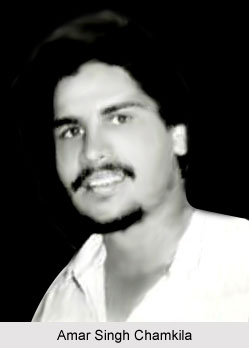 Amar Singh Chamkila was born on 21st July in the year 1960. He was a controversial songwriter, singer and musician. It often seen that his critics often criticized the vulgarity in his songs while his fans relished their sensual appeal. He was also popular among the singers fraternity in the Indian state of Punjab, as he was one of the major live performer or Akhara singers in the state. During his heydays, he was known for performing in three different stages in a particular day.
Amar Singh Chamkila was born on 21st July in the year 1960. He was a controversial songwriter, singer and musician. It often seen that his critics often criticized the vulgarity in his songs while his fans relished their sensual appeal. He was also popular among the singers fraternity in the Indian state of Punjab, as he was one of the major live performer or Akhara singers in the state. During his heydays, he was known for performing in three different stages in a particular day.
Early Years of Amar Singh Chamkila
Amar Singh Chamkila was born on 21st July in the year 1960 in the village of Dugri near the Ludhiana district in the Indian state of Punjab. He was actually born to a poor family and Chamar caste. He was the youngest child of Hari Singh and Kartar Kaur, and received his education at Gujar Khan Primary School in Dugri. He wanted to become an electrician, but his dream remained unfulfilled and eventually got a job at Ludhiana cloth mill.
He had a natural appetite for music and learned the art of playing the Dholki and Harmonium.
Family Life of Amar Singh Chamkila
Amar Singh was married to Gurmail Kaur and had two daughters named Amandeep Kaur and Kamaldeep Kaur. His daughter - Kamal, has followed the footsteps of her father and become a singer, and, as a singer, has also released her own albums. The album, apart from recorded songs, also contains unsung but written lyrics by her father. He later married his co-singer Amarjot while still being married to his first wife.
Rise to Fame of Amar Singh Chamkila
With some name and fame for himself, he adopted a stage name Amar Singh Chamkila - Chamkila in Punjabi means one that shines. He partnered up with a female vocalist Surinder Sonia and recorded eight duets, and the record were released in the year 1979 and was produced by Charanjit Ahuja. The smart lyrics, which he penned himself, were an instant hit among the audience.
In the year 1980, Chamkila left Sonia and did set up a short lived stage relationship with Miss Usha. But, in favour of teaming up with Amarjot - a female folk singer, he left Miss Usha the same year. Amarjot herself was a renowned singer and sang with Kuldip Manak. She would become Chamkila`s permanent singing partner providing the female vocals for his duets, that is, the majority of the songs that he wrote.
For most part of his career, Chamkila wrote his own lyrics. Major part of his lyrics are basically suggestive and boyish, yet very much fluent - commentaries on drug use, sex and extramarital affairs. Most of his lyrics have a double meaning.
Chamkila was very popular among his fans, much of which he acquired through intense performances in the free and open air concerts in a around the state of Punjab. He teamed up with many female-singers to produce some of the best songs, which are still popular among the people. Chamkila and Amarjot in the year 1985, released three devotional LPs: Baba Tera Nankana, Talwar Main Kalgidhar Di Haan and Naam Jap Le. He recorded in excess of 90 songs before he was killed in Mehsopur, Punjab in the year 1988. It is rumoured that, at the time of his death, he reportedly had 200 songs that had not been sung or recorded. Of these some were sung at stage shows including Dhee Mar Jai Badkar Loko, Jatt Di Dushmani and Akhiyan Di Maar Buri. Chamkila also wrote and sang another serious song on the folk hero Jeona Morh called Kaadha Soorma, which was remixed by Panjabi MC in 2007.
He also had many solo songs which have been sung in recent times by artists such as Nirmal Sidhu, Amar Arshi, and even his teacher Surinder Shinda. Some singers have used some of Chamkila`s lyrics in their songs as part of their chorus. These include Nasha, Mere Yaar Ne (Gippy Grewal) and Shad De Vairne Yaari (Jazzy B).
The appeal of Chamkila`s music prominently lay in both the content of his lyrics and the delivery of those lyrics.
Discography of Amar Singh Chamkila
Chamkila`s recordings on the HMV music label have been recompiled for release on CD by Saregama.
* Hikk Utte So Ja Ve
* Lak Mera Kach Warga
* Mitra Main Khand Ban Gai
* Sharbut Vangoo Ghut Bhar Laan
* Bhul Gai Main Ghund Kadna
* Yaad Aave War War
* Baba Tera Nankana
* Naam Jap Le
* Talwar Main Kalgidhar Di Haan
* Jija Lak Minle




















